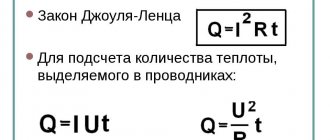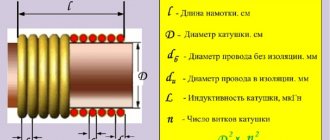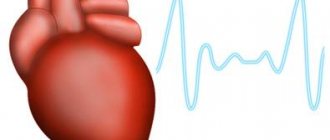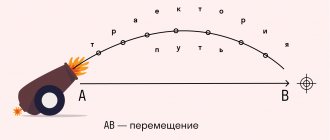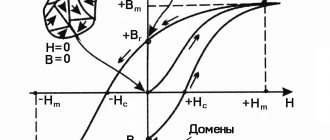Resonance phenomena are observed in oscillatory systems when the frequency of natural oscillations of the system elements coincides with the frequency of external (forced) oscillatory processes. This statement is also true for circuits with circulating alternating current. In such electrical circuits, under certain conditions, voltage resonance occurs, which affects the current parameters. The phenomenon of resonance in electrical engineering can be beneficial or harmful, depending on the situation in which the process occurs.
In Ozhegov's dictionary
RESONANCE, -a, x 1. Excitation of vibrations of one body by vibrations of another of the same frequency, as well as the response sound of one of two bodies tuned in unison (special). 2. The ability to amplify sound, characteristic of resonators or rooms whose walls reflect sound waves well. R. violins. 3. transfer An echo, an echo, an impression made on many. The report was received by a wide public r. || adj. resonant, -th, -oe (to 1 and 2 values). Resonance spruce (for making musical instruments; special).
Types and examples of resonance
The phenomenon of resonance rightfully belongs to physics, since it was discovered by it and initially described only physical phenomena.
However, today this concept is used in a variety of spheres of life.
In this regard, we can distinguish its different types:
- Mechanical - the above-mentioned swing, the swinging of the bell “tongue”, the resonance of the bridge from a passing train or soldiers walking along it “in step”, etc.
- Acoustic – an example is the sound resonance used in playing musical instruments, such as guitar, balalaika, lute.
They all have a body and it was invented for a reason: the sound that the string makes when it is plucked goes inside the body. There it resonates with the walls, which leads to its amplification. Therefore, the sound quality directly depends on the quality of the material from which the instrument is made and even on the varnish with which it was coated. - Electrical – the coincidence of the frequency of the external voltage with the natural frequency of the electrical circuit through which the current flows.
- Public – a vivid response of the public to an event, phenomenon or situation. We are talking about a reaction that turned out to be similar among the majority of people. For example, the pension reform of 2022 caused a loud, sharp, negative resonance among the citizens of our country.
- Cognitive resonance is a coincidence of views and opinions.
For example, you met someone: as a result, you have a positive impression of the person. Why is this so? The whole point is that during the conversation you found a lot in common with him, his values and judgments turned out to be close to you, hence the sympathy, which is a consequence of resonance. From a philosophical point of view, the phenomenon is defined as the unanimity of two souls in a sensory context.
Mobile phones, microwave ovens, televisions, echoes in the mountains, sonorous singing in the bathroom - the phenomenon in question is present everywhere.
In the dictionary D.N. Ushakova
RESONANCE, resonance, plural. no, husband (from lat. resonans - giving an echo). 1. The response sound of one of two bodies tuned in unison (physical). 2. The ability to increase the strength and duration of sound, characteristic of rooms whose internal surface can reflect sound waves. There is a good resonance in the concert hall. There is poor resonance in the room. 3. Excitation of vibration of a body, caused by vibrations of another body of the same frequency and transmitted by an elastic medium located between them (mechanical). 4. The relationship between self-induction and capacitance in an alternating current circuit, causing maximum electromagnetic oscillations of a given frequency (physical, radio). 5. transfer Echo, echo (book).
Resonance is...
The concept of resonance was first introduced in the 16th century by Galilio Galei, when he was studying the work of pendulums and musical strings.
Translated from Latin, the word “resonance” literally means “ I respond ” and is a physical phenomenon in which one’s own oscillatory movements become forced and increase their amplitude, thus responding to environmental influences.
In simple words, resonance is a response to a certain stimulus from the outside. This is the synchronization of oscillation frequencies (the number of oscillations per second) of a certain system and the external force acting on it, which entails an increase in the amplitude of oscillations of this system.
Resonance can be described as follows:
- imagine a certain physical body that is either in a state of absolute rest or makes amplitude movements of a certain frequency;
- this body suddenly begins to be influenced by a certain external force that has its own amplitude and frequency;
- if the frequencies of the body and the external force coincide, then the amplitude of the body will begin to increase.
For example , everyone knows how a swing “works”. First, you make a sharp push with your feet from the ground, and the swing begins to move back and forth. If you do not interfere with this process, then after a while they will stop.
But if, while sitting on them, you adapt to their movement with your whole body (neither faster nor slower), then the amplitude of the movements of the swing will begin to increase on its own. In this case, you, or rather your movements, are an external influence, a compelling force, with the help of which the swing soars higher.
Even the smallest external influence can increase the amplitude of movements of a certain system many times over when their frequencies coincide. From the example of a swing: a small child can swing an adult even with a very large weight if he adapts to the movement of the swing.
To better understand what resonance is, let's look at its antonym. It is the word “ dissonance ” (from the Latin “discordant”), which means discrepancy, discrepancy.
Let’s take a swing again as an example: if you start jerking it sharply and chaotically back and forth, the smooth, swinging vibrations will soon disappear and the swing will stop. Another simple example: if you go outside in a fur coat in the summer, it will be dissonant, since the weather does not match your outfit.
In the dictionary Dictionary of foreign words
a, pl. No m.
1. those. Excitation of vibrations of one body by vibrations of another of the same frequency, as well as the response sound of one of two bodies tuned in unison.
2. The ability to amplify sound, characteristic of resonators or rooms whose walls reflect sound waves well. R. violins. Call R. Resonant - related to resonance.||Cf. REVERBERATION" title='REVERBERATION, REVERBERATION is what REVERBERATION is, REVERBERATION interpretation'>REVERBERATION, ECHO.
3. trans. Echo, echo, impression. The play had a great public impact.
Share the meaning of the word:
What does sound depend on?
The more the speed of sound in air and stone differs, the better the reflection. Thus, in granite sound diverges at a speed of 4 × 103 m/s, in air - 3.3 × 102 m/s. Consequently, a small amount of energy will be released into the air, and the main part will be “closed” inside the stone. The “singing” block lies on other stones; it has a weak acoustic connection with the ground, because it touches the ground only in a few places. It turns out that the sound cannot go into the ground. Such objects that can contain vibrational energy within themselves are called resonators. What happens in the middle of the “singing” stone upon impact? The waves are reflected many times from its walls, decreasing or increasing with sound resonance. Amplification occurs when a wave, having been reflected, returns in the same phase in which it began its journey.
Helmholtz resonator
Humanity has known the amazing properties of empty vessels for a long time. Ancient architects used knowledge of sound resonance when building a theater: they placed bronze vessels in the walls to make the voices of the actors sound louder. Helmholtz resonators are widely used in acoustics. Helmholtz is a German scientist who substantiated the theory of hearing from a physical point of view. Using a set of resonators named after him, complex sounds can be analyzed based on the frequency of the wave's oscillations.
How does a resonator work? It is a spherical or bottle-shaped vessel with a narrow neck. The whole secret lies in the sound resonance of the vibrations of the air that is inside. The sound wave is complex. It consists of many vibrations. But each of the resonators responds best to the frequency that is equal to its own, that is, the frequency of vibration of the air enclosed in the cavity. What does it depend on?
If the resonator is shorter than the sound wavelength, then its operating principle is the same as that of a spring pendulum. The air in the narrow neck moves much faster than in the resonator itself. It is the vibrations in the neck of the vessel that play the main role. It turns out that the kinetic energy is concentrated mainly in this bottleneck. Elastic energy is carried by the air mass located inside the resonator.
There is much less air in the neck than inside, so the change in its volume during oscillations is usually neglected. It is conventionally believed that this entire mass moves as a single whole, like an air plug, and the volume of air inside the resonator changes greatly. It turns out that the air inside works like a spring in an oscillatory system. Its influx blocks the path of other air into the vessel, and the outflow lowers the pressure and prevents the release of air from the inside. When the air plug goes down, it compresses the nearby layer of air inside the resonator, i.e., increases its density. As a result, the growing pressure sets in motion the next layer of air, then another, etc. Thus, the compression spreads across the layers, transmits its momentum, and a sound wave arises.
It is now clear that the cause of the creepy voices in the apartment building was sound resonance. The howling of the wind and other noises from the street are disordered harmonic vibrations of different frequencies. They are called pure tones. When passing through the wall, all frequencies except resonant ones weakened. Resonant frequencies are those that coincide with the frequencies of the air in empty vessels. Moreover, they could even intensify. The policemen panicked because they heard sounds unusual for humans and living beings. The fact is that our speech sounds at a frequency much higher than 100 hertz, and the “brownie” made unusually low sounds.
Resonance in electrical circuits as a phenomenon
Resonance frequency: formula
The general definition of resonance is quite acceptable for considering similar electrical processes. The nature of the phenomenon in this case depends on the parameters of the components that form the signal path. The induction element and capacitor act as energy storage devices. A gradual decrease in amplitude provides electrical resistance - an analogue of the friction force in a mechanical system.
A distinction is made between parallel and series resonance when choosing the appropriate circuit design. In the first option, an increase in current strength is provided when the frequencies coincide. The second is tension.
The value of the operating parameters of the circuit can be determined after calculating the impedance (Z). When connecting a typical chain in series ( R , L and C ), the following formula is used:
Z = √ R2 + (2π * f * L - 1/2π * f * C)2.
According to Ohm's law, it is easy to determine the current:
I = U/Z = U/ √ R2 + (2π * f * L - 1/2π * f * C)2.
Formulas and amplitude-frequency characteristics of a series circuit
What voltage resonance is is shown in the figure.
Series oscillating circuit
In an oscillatory circuit you can obtain undamped oscillations if you connect it to an alternating current source. If the source is connected in series with a coil L and a capacitor C, then such a circuit is called a series oscillatory circuit (Fig. 3).
When an external source is connected to the circuit, it is not the circuit’s own (free) oscillations that arise, which are determined by the values of L and C, but with the frequency of the source voltage U=Um∙sinω∙t. Such circuit oscillations are called forced. During forced oscillations, the circuit elements L, C will have, depending on the source frequency, certain inductive XL and capacitive Xc resistances and corresponding voltage drops UL, Uc across them. But the circuit has not only reactance, but also an active loss resistance R, which is basically equal to the resistance of the coil wire.
Since the voltages in the coil and capacitor are shifted relative to the current by different phase angles, they can be shown more clearly in vector diagrams (Fig. 4)
It will be interesting➡ What is an RCD?
The voltage across the inductive reactance UL leads the current by 90°, and the voltage across the capacitive reactance Uc lags the current at the same angle of 90°. And it turns out that the vectors UL and Uc are shifted by 180°, i.e. are in antiphase. The voltage vector at the source U will be equal to the geometric sum of the voltage of the vector UR and the vector of the voltage difference of the reactances UL-Uc.
As can be seen from the diagram in Fig. 4a, at UL > Uc, the external source voltage leads the current in the oscillatory circuit by an angle φ<90° and is located above the abscissa axis in the inductance voltage zone. This means that in this case the circuit has an inductive resistance. At UL < Uc (Fig. 4b), the source vector will already lag behind the current vector by an angle φ<90° and the circuit will have capacitive reactance.
The total resistance of the circuit Z will be equal to:
The amplitude value of the current Im is determined by the formula:
where Um is the amplitude voltage of the source, and ω is its angular frequency.
When equality is satisfied:

